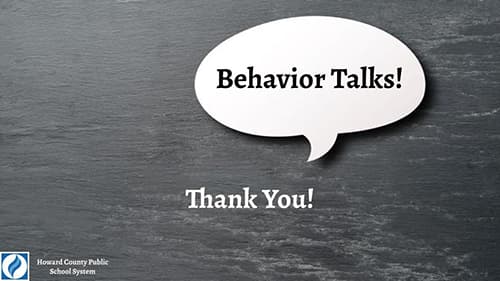Giving Feedback and Praise
Transcript
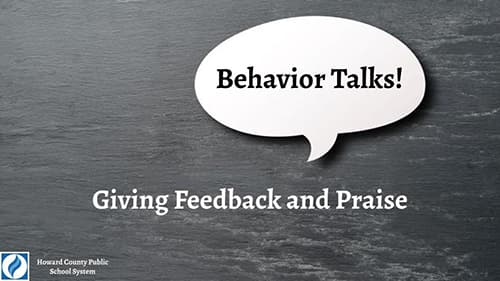
Title
Welcome to Behavior Talks: Giving Feedback and Praise.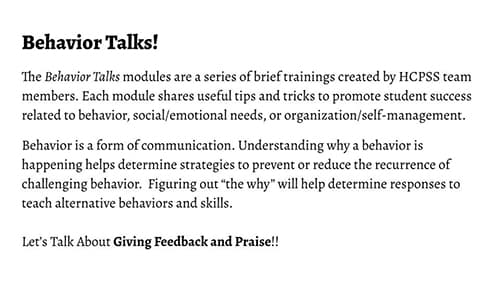
About Behavior Talks!
The Behavior Talks modules are a series of brief trainings created by HCPSS team members. Each module shares useful tips and tricks to promote student success related to behavior, social/emotional needs, or organization/self-management.
Behavior is a form of communication. Understanding why a behavior is happening helps determine strategies to prevent or reduce the recurrence of challenging behavior. Figuring out “the why” will help determine responses to teach alternative behaviors and skills. Let’s Talk About Giving Feedback and Praise!!
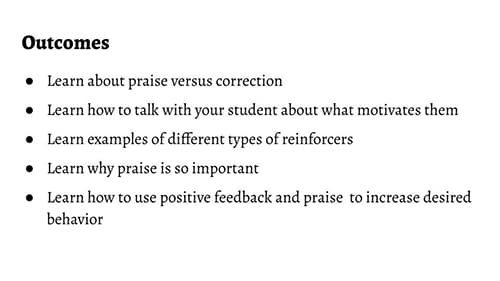
Outcomes
In this video you will learn about praise versus correction, how to talk with your student about what motivates them, learn examples of different types of reinforcers, learn why praise is so important, and learn how to use positive feedback and praise to increase desired behavior.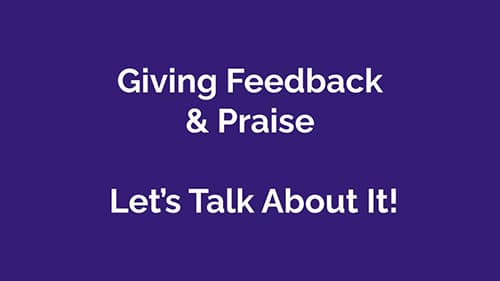
Giving Feedback and Praise
Giving feedback and praise. Let’s talk about it!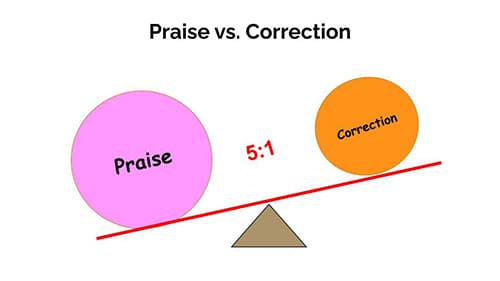
Praise vs. Correction
People tend to pay more attention to undesired behaviors that they don’t expect to happen. Additionally, caregivers or teachers are also more likely to correct their students for what they’re doing wrong rather than giving them positive feedback or praise for what they’re doing right.
Students typically respond better to positive feedback or praise than negative feedback or correction. How can we get our students to choose socially appropriate or desired behavior over other behavior?
We have to help students make a connection with praise and desired behavior. Many educators and behavior specialists encourage the use of a five to one ratio of positive feedback and praise to negative interactions or corrections. That means five positive interactions should occur for each negative correction. While providing 5 positive interactions to every negative correction may not come naturally at first, it is something that can be learned.
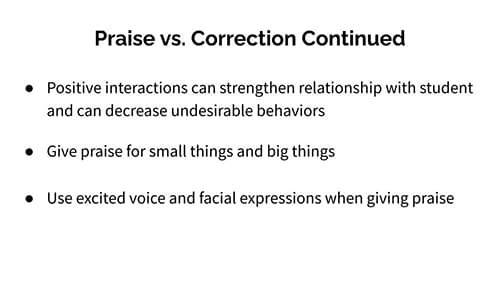
Praise vs. Correction Continued
Also, engaging in positive interactions can strengthen the relationship between you and your student, and can decrease undesirable behaviors.
Praise should be given for both the small things and the big things your student does. When giving positive feedback or praise, be sure to use an excited voice and facial expressions to show your student that you are pleased. This will increase the effectiveness of the technique.
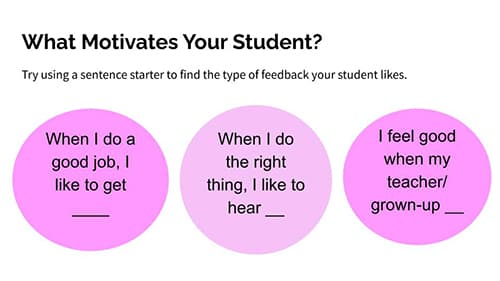
What Motivates your Student?
Many caregivers assume students are motivated to do well by grades, treats, or money, but it’s important to check in periodically with your student about what they want when they do well.
Here are some examples of sentence starters to help your student share what motivates them.
For students who respond better to pictures instead of written words, you could show pictures of items or show the actual items that are available as rewards.
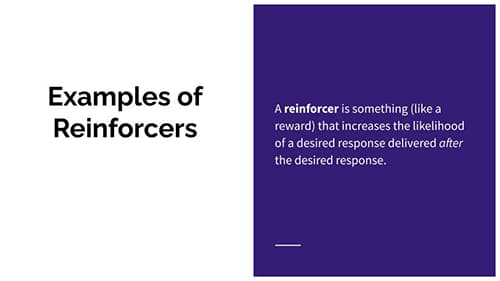
Examples of Reinforcers
A reinforcer is something (like a reward) that increases the likelihood of a desired response by being delivered after the desired response. The following slides provide examples of different types of reinforcers or things that may be motivating to your student.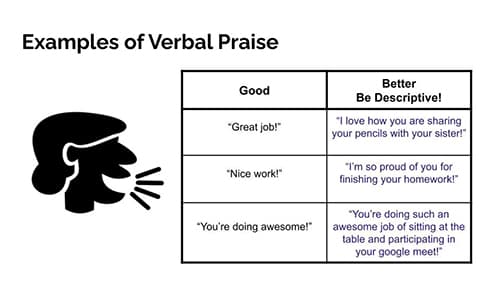
Examples of Verbal Praise
Giving verbal praise to desired behaviors that you want to see from your student can help increase the likelihood that you will see more of that socially expected behavior from your student. You want to try and “catch your student” in the moment when they are engaged in desired behavior! Not only is it important to catch them in the moment, but it’s just as important how you deliver that verbal praise. There’s good verbal praise and then there’s better verbal praise! “What’s meant by better verbal praise is to be as descriptive as possible so that your student knows exactly which behavior they are doing is right. No matter their age, students will feel good when you let them know that you recognize and appreciate their appropriate behavior. When they know exactly what they are being praised for, they will be more likely to do it again in the future.
For example, when your student decides to share pencils with a sibling, instead of just saying “Great job!”, say: “I love how you are sharing your pencils with your sister!” By specifically giving verbal reinforcement, which in this case is praising for sharing the pencils, your student knows exactly what they did right and can engage in similar behavior in the future.
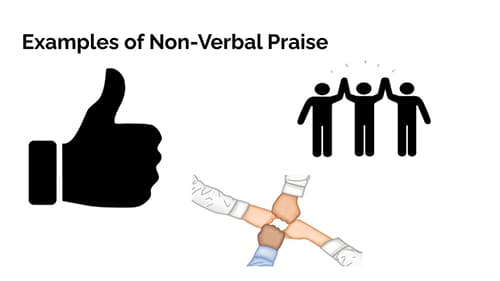
Examples of Non-Verbal Praise
Non-verbal praise is a type of reinforcement that is just as powerful as verbal praise. Giving your student a thumbs up, high five or fist bump is a quick and easy way to let your student know that you like what they are doing.
If your student puts their dishes in the sink and you give them a thumbs up, the thumbs up is the non-verbal reinforcer. Or, if your student works on their math homework and you give them a fist bump or a high five, the fist bump or high five is the non-verbal reinforcer.
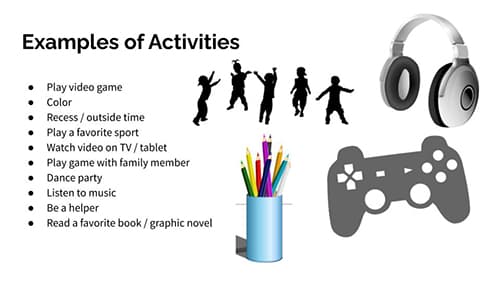
Examples of Activities
Here are examples of some activities that could be motivating or reinforcing for your student. Take a minute to review these ideas.
After reviewing these activities, think about what your student might find reinforcing. Be sure to ask your student about their favorite activities! You might be surprised about what they like and what they don’t like.
For example, if your student doesn’t like to complete their homework, you could provide an incentive to play video games for 20 min if they finish their homework. However, if you choose this reinforcer make sure that your student only gets access to playing video games for completing homework.
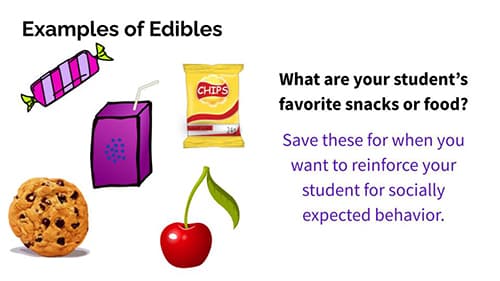
Examples of Edibles
Edibles or things that you can eat or drink can also be highly motivating for students. If you decide to use a favorite food or drink item as a reinforcer be sure that your student doesn’t have access to those items at any other time, otherwise it won’t have the same impact.
For example, if your student loves chocolate chip cookies and can eat them whenever they want, trying to offer the cookie as a reward for submitting their asynchronous work on Canvas likely won’t work because the student knows they could get the cookie at another time.
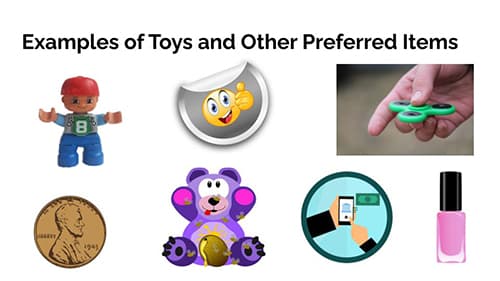
Examples of Toys and Other Preferred Items
Preferred toys are different across age levels and interest areas. What a 3-year old finds motivating will be different from what motivates a teenager. Collecting coins, money, or stickers might be motivating to some students, while stuffed animals, action figures, fidget spinners, lip gloss, nail polish, or video game currency motivates others.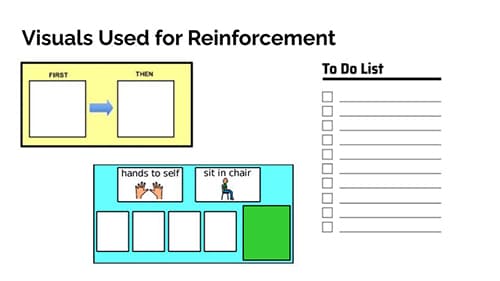
Visuals Used for Reinforcement
Some students need visual supports for praise. A simple First Then Board can be a visual representation of how they get reinforcement. A picture of the activity they are to complete is in the First Box and then a picture of a reward is placed in the Then Box.
The board on the bottom is called a token board. Token boards display what is expected of the student. A token can be anything like a picture of a star, smiley face, or check mark. A token is delivered when the desired behavior occurs. Once the student earns all of their tokens, they may have access to their reinforcer. The tokens are removed from the board and the student has the chance to earn the reward again.
A simple To Do List can also be used for reinforcement. Tasks the student needs to complete are listed and as each task is finished the student checks it off as complete. Once the list is finished, the student earns the reward.
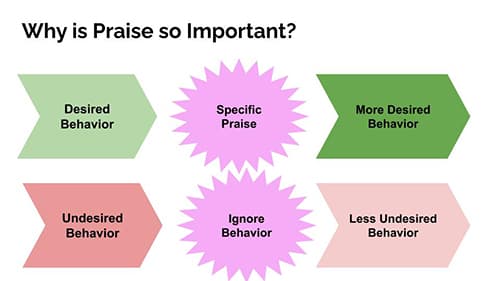
Why is Praise so Important?
If you want to increase desired behaviors, then give praise to your student when you see them engaging in the behaviors that you want them to do. But what about when your student does something that you don’t want them to do? Actively ignore undesired behavior unless it is unsafe. By ignoring the undesired behavior you are sending the message that the undesired behavior is not the way for your student to get what they want. As soon as you see your student doing the desired behavior, immediately give them specific positive feedback and praise. You can talk about the undesired behavior that happened with your student at a later time.
If your student is being unsafe, it’s important to respond calmly and address the safety issue immediately. Be mindful of the intensity of your feedback and how much feedback you are giving for an unsafe behavior. You do not want your student to associate too much feedback with unsafe behaviors.
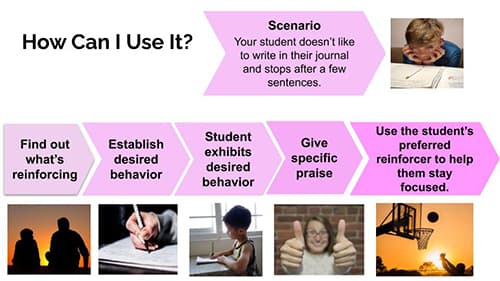
How Can I Use It?
Let’s use a common scenario to see how using praise and feedback looks in action. Maybe your student really hates writing. First, choose a neutral time and find out what motivates them. Next, give specific verbal praise whenever you see them writing. Saying, “I love to see you working so hard on your writing,” recognizes your student’s effort and gives them a good feeling about their work. Maybe your student’s preferred reinforcer is basketball, so you might say “Two more good sentences and we can shoot 22 hoops outside! What do you think?” Can’t do the outside time? Maybe an indoor version with paper balls in the trash can will do the trick. Your student will learn that you give your positive praise to hard work and will associate hard work with feeling good.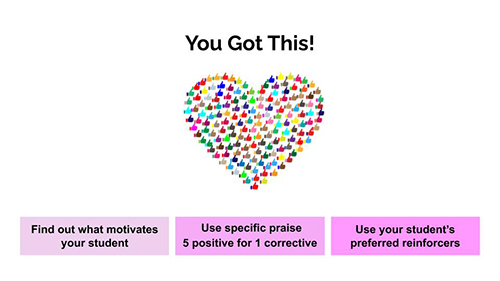
You Got This
Using specific praise and regularly incorporating reinforcers will take time and practice. Remember to regularly check in with what motivates your student and give specific praise with at least 5 positive interactions for each negative or corrective one. Use your student’s preferred reinforcers to help keep them focused and to increase desired behavior. Feel free to refer back to this video for ideas about motivating your student.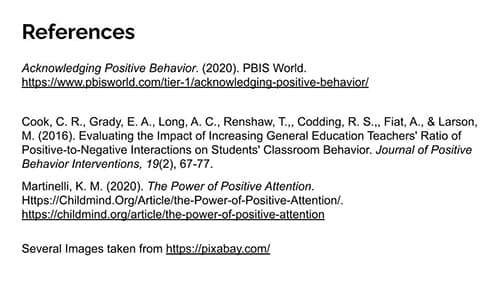
References
Acknowledging Positive Behavior. (2020). PBIS World. https://www.pbisworld.com/tier-1/acknowledging-positive-behavior/
Cook, C. R., Grady, E. A., Long, A. C., Renshaw, T., Codding, R. S., Fiat, A., & Larson, M. (2016). Evaluating the Impact of Increasing General Education Teachers’ Ratio of Positive-to-Negative Interactions on Students’ Classroom Behavior. Journal of Positive Behavior Interventions, 19(2), 67-77.
Martinelli, K. M. (2020). The Power of Positive Attention. https://childmind.org/article/the-power-of-positive-attention
Several Images taken from https://pixabay.com/
